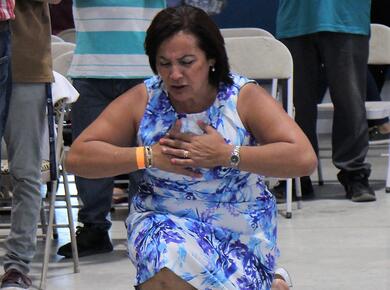Posted: June 9, 2022
Anabaptists and Pentecostals
The Global Anabaptist Project* says: “Pentecostalism is the most rapidly growing expression of Christianity in the world, and Anabaptists are not foreigners to this reality.”
Anabaptists around the world experience this by practicing an expression of faith that César García, general secretary of Mennonite World Conference, calls “Mennocostal.”
Many Anabaptist-Mennonites today combine Christ-centred theology and emphasis on peacemaking with a spontaneous Spirit-led approach that is often associated with Pentecostalism and charismatic movements.
However, the vibrancy of these rapidly growing churches can also cause discomfort when their expansion seems to come at the expense of one’s own family.
What does the growth of Pentecostalism mean for Anabaptists?
“Pentecostalism is in our century the closest parallel to what Anabaptism was in the 16th century,” wrote C. Arnold Snyder in Anabaptist History and Theology
Anabaptism has been shaped and reshaped by waves of renewal. There were the passionate and risk-taking re-baptizers of the sixteenth century; Pietist revivals among Mennonites in what is now Ukraine; the influence of the East Africa Revival of the 1930s on Kanisa la Mennonite Tanzania and Kenya Mennonite Church; the birth of JKI (Jemaat Kristen Indonesia) within a youth prayer movement; the flourishing of Meserete Kristos Church in Ethiopia in the 1980s despite political persecution.
“Pentecostal movements, charismatic renewals make a similar experience as we did as AnabaptistMennonites. Fresh reading of the Bible together, being inspired, the freedom, the joy,” says Bernhard Ott, retired dean of Bienenberg, a Mennonite Bible institute in Switzerland.
But “openness to what God is doing is also linked to uncertainty and lack of control,” he says. A process of institutionalization challenges spontaneity for better or worse. The waves of Anabaptist renewal developed theology, training, critical reflection, and lost some openness in the process.
“The Anabaptist movement… started losing the enthusiasm that accompanied it at the beginning,” says Pedro Calix, a Mennonite pastor from Honduras.
What opportunities does the burgeoning Pentecostal movement hold for Anabaptists?
“It is a great opportunity to rethink the idea of returning to our charismatic roots and open ourselves to what the Holy Spirit wants to do within our faith communities while not losing our Anabaptist identity,” says Pedro Calix.
Neal Blough observes how worship in a Pentecostal style connects with those from the Majority World more than the rational forms of Swiss or Russian streams of Anabaptism. Professor emeritus of church history at Faculte Libre de theologie Evangelique in France, he worships with an urban congregation located in Europe but influenced by members from the rest of the world. “How much is it theological and how much is it cultural?” he asks. “Pentecostal and charismatic worship is more bodily, corporal, expressive, lively, joyful, and that corresponds to what I know of people from the Global South.”
For the Mennonite Brethren church in Brazil, the departure of congregations from the plateaued Anabaptist conference to rapidly growing Pentecostal movements caused leaders to realize an opportunity.
“We can see in Scriptures that the early church was led by the Holy Spirit. We value the Word of God. Yet, we didn’t know what it means to be led by Holy Spirit,” says Rodrigo Justino, a Mennonite Brethren pastor from Brazil, now studying theology in Canada. As both movements encountered each other in learning, the Mennonite Brethren in Brazil now “are not Pentecostal. But we’re not only Anabaptist. We’re a mix of both.
“Pentecostals bring in pathos; it’s not only emotion in a cheap way, but it’s the affections. Pentecostals bring back a spiritual dimension [to orthopraxy]: it’s the power of God, the power of the Spirit that transforms us; we don’t just do it ourselves,” says Bernhard Ott. “We can learn much from that.”
Anabaptist-Mennonites are known for theological focus on living (orthopraxy).
Ethics can become a burden without the power of the Holy Spirit; we require “spiritual power for the Anabaptist vision,” says Bernhard Ott. Pentecostal perspectives can help remind AnabaptistMennonites of our theology of the reign of God which is “already-and-not-yet. God’s power is breaking now, not just in the future.”
To the extent that the church is a place of societal transformation and a promoter of peace and justice, it is a sign of the reign of God.
What are the challenges?
Anabaptist-Mennonite churches in Latin America have many influences from Pentecostalism.
Among the negative effects are “that the liturgy often uses Biblical texts out of context, which can be seen in some of the songs that place a lot of emphasis on spiritual warfare or the prosperity gospel,” says Pedro Calix.
Rodrigo Justino notes that in Brazil, Pentecostals “don’t focus on criteria for authority – they focus on gifts. They can’t deny the woman has pastoral gifts: a prophetess, an evangelist.” However, the “top” leadership of the churches still skews male.
Pentecostal churches often rely on the spirituality of the founder; a dynasty is built. “There can be a problem of holding on to power,” says Rodrigo Justino.
In Indonesia, JKI founder’s passion for prayerful, Spirit-directed service has permeated the movement; his Mennonite roots are less evident, says Rony Kristanto, a pastor in the “Mennocostal” JKI synod.
Rapid growth can drive this problem of theological grounding. Pentecostal movements can grow “as vast as the ocean but as shallow as a puddle,” says Rodrigo Justino. “They can become prey to other movements. We [Anabaptists] can help in terms of theology. They can help us discern voice of the Spirit, what it means to live by faith. To start something, you don’t need to have money, structure; you only need faith, courage to preach. Everything else the Lord will do among us. This is a huge lesson.”
Pentecostalism is still characterized in some ways by the first-generation experience of newness and signs and wonders.
“Every Protestant movement has had this cyclical process,” says Neal Blough. Those in new movements need to think theologically, realize they are not the first Christians, observe how others have navigated the shift to become more structured and learn from them.

What gifts might Anabaptists – now a mature movement – and the still-young and developing Pentecostal movement hold for each other?
“The gifts of service, solidarity, discipleship, and teaching,” says Pedro Calix.
“We all want to bring God’s reign to come to this world,” says Rony Kristanto.
“Pentecostals try to materialize and manifest salvation through healing and salvation and physical blessing… [something that] happens here and now.
This testimony of salvation, this good news, is not in heaven, in the future, it is now. “A problem in Indonesia is people don’t have social security, so physical healing is very important for them.”
The early members of JKI followed this example. “It started with prayer. Every time before they went to a [ministry] area they were praying for this area,” Rony Kristanto says.
“Social engagement cannot be separated from charismatic experience of Holy Spirit,” he says. Mennonites also work with the poor and oppressed, but Pentecostals minster “not only as social work but due to vision, prayer,…spiritual warfare.”
“We need to sing each other’s songs,” says Neal Blough, referencing the work of Janie Blough who studies and teaches worship. “We need to sing each other, not draw into only one stream.”
The vibrance of Pentecostal worship has lessons of vitality for Mennonites, but the Anabaptist tradition offers the insight that forming disciples is a deeper process than emotional music and a sermon
“Anabaptist-Mennonites have something to offer regarding humility and community,” says Neal Blough. Discipleship and ethics are also helpful correctives to a movement that tends to be too individualistic.
He observes increasing ecumenical engagement from Pentecostals where they are seeking other church’s experience in becoming more structured as a maturing movement.
Anabaptist Mennonites can be corrective to Pentecostals to not only look at wonder and power, but to look at ethics – how you live; the peace witness, says Bernhard Ott. “Word and works has always been with Anabaptist-Mennonite theology and practice. The Pentecostal movement brings in experiencing the power of God. This is a good challenge…. Mennonites can speak to Pentecostals if it becomes too one sided.”
Retired theology professor Claude Baecher observes an interest in Anabaptist history and theology in his region in France.
“Being close, present, even fraternal to these churches seems to me as important as our involvement in ecumenical circles. This has to be done with a strong Christcentered biblical approach.
“We should avoid too rapid (spiritual) judgment and be present with teaching tools: Anabaptist history, exegesis, ethics, practical theology, peace-centred theology, dialogue,” he says.
And with humility.
In Brazil, struggling with a potential church schism between the older, conservative Mennonite Brethren churches and new churches following a Spiritled path, church leaders found a way through by learning humility together. “We struggled with our pride, our resentment [about members leaving]. We were grasping opportunities and protecting ourselves from threats,” says Rodrigo Justino.
“It’s about what God is doing in terms of grace,” says Rodrigo Justino. Follow Jesus in humility. “When you decide to do this, you have beauty. It’s different than you and me, us and them, it starts to be us. We work together.”
—Karla Braun is editor of Courier and writer for Mennonite World Conference. She lives in Winnipeg, Canada.
* Global Anabaptist Profile (GAP), an extensive three-year survey of 24 member conferences of Mennonite World Conference (MWC). Learn more: https://mwc-cmm.org/courier/stories/uniqueopportunity-greater-unity


Join the Conversation on Social Media
FacebookTwitterInstagramFlickrYouTube